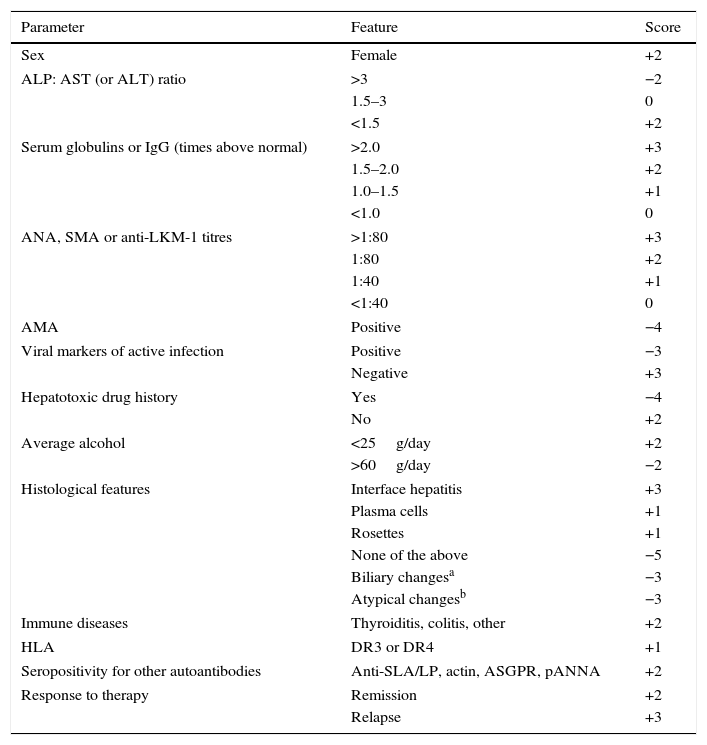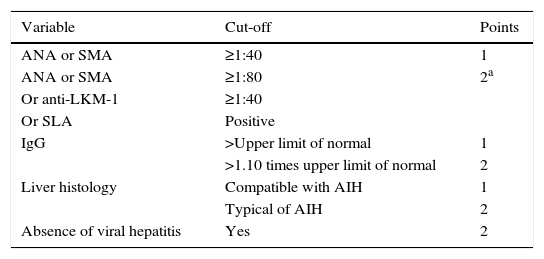Autoimmune hepatitis (AIH) is a progressive inflammatory hepatopathy and an important cause of end-stage liver disease. Its aetiology remains unknown, though both genetic and environmental factors are involved in its development. The major mechanism of autoimmune liver damage involves immune reactions against host liver antigens. Numerical and functional defects of regulatory T-cells play a permissive role enabling autoimmune liver injury to occur and persist. The most typical features of AIH are female preponderance, hypergammaglobulinaemia, seropositivity for circulating autoantibodies and a picture of interface hepatitis on histology. Two types of AIH are distinguished according to serological profile: AIH type 1 patients are positive for anti-nuclear and/or anti-smooth muscle antibodies, whereas AIH type 2 patients are defined by the positivity for anti-liver kidney microsomal type 1 antibody and/or for anti-liver cytosol type 1 antibody. Clinical manifestations are variable, and AIH onset is often ill-defined, frequently mimicking acute hepatitis; its course may be fluctuating. AIH responds to immunosuppressive treatment in the majority of cases. Steroids with or without azathioprine should be instituted promptly upon diagnosis. Remission is achieved in some 80% of patients. For the remaining 20% of patients, alternative immunosuppressive agents such as mycophenolate mofetil and calcineurin inhibitors are an option. Liver transplantation should be considered for those patients who progress to cirrhosis and develop complications of end-stage liver disease, as well as for those presenting with acute liver failure; outcomes are excellent, although the disease may recur in the allograft.
La hepatitis autoinmune (HAI) es una hepatopatía inflamatoria progresiva y una causa importante de insuficiencia hepática terminal. Su origen continúa siendo una incógnita, si bien influyen en su evolución factores tanto genéticos como ambientales. El principal mecanismo de daño hepático autoinmune son las reacciones inmunitarias contra los antígenos hepáticos del receptor. Los defectos numéricos y funcionales de los linfocitos T reguladores desempeñan un permisivo papel a la hora de propiciar que la enfermedad hepática autoinmune se produzca y perdure. Las particularidades más típicas de la HAI son el predominio femenino, hipergammaglobulinemia, seropositividad para autoanticuerpos circulantes e imagen de hepatitis de interfase en la histología. Se distinguen 2 tipos de HAI conforme a su perfil serológico: los pacientes con HAI tipo 1 dan positivo para anticuerpos antinucleares y/o antimúsculo liso, mientras que los pacientes con HAI tipo 2 dan positivo para el anticuerpo antimicrosomal de hígado tipo 1 y/o para el anticuerpo contra el citosol hepático 1. Los signos clínicos varían, y el inicio de la HAI suele estar mal definido, imitando hepatitis aguda; su evolución puede fluctuar. La HAI remite con tratamiento inmunodepresor en la mayoría de los casos. Los corticosteroides con o sin azatioprina deberían iniciarse inmediatamente después del diagnóstico. La remisión se consigue en alrededor del 80% de los pacientes. Para el 20% restante, una opción son los fármacos inmunodepresores, como el micofenolato de mofetilo o inhibidores de calcineurina. El trasplante hepático debe ser tenido en cuenta para aquellos pacientes que cursen con cirrosis y padezcan complicaciones de insuficiencia hepática terminal, así como para los que experimenten insuficiencia hepática aguda; los resultados son excelentes, si bien la enfermedad podría recidivar en el alotransplante.
Article
Diríjase desde aquí a la web de la >>>FESEMI<<< e inicie sesión mediante el formulario que se encuentra en la barra superior, pulsando sobre el candado.

Una vez autentificado, en la misma web de FESEMI, en el menú superior, elija la opción deseada.

>>>FESEMI<<<










